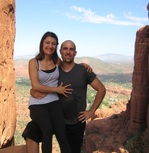After 31 years and thousands of animals ingested, today was the first day I saw the meat I was going to eat slaughtered and cleaned right in front of me. In our attempt to avoid factory farmed meat, Neda’s Dad Petko found a local farm that sold goats and lambs (as well as the cheese and milk produced by them) and this morning we went off to buy a little goat. I asked if we could go early to witness the process of slaughter. It sounds like a morbid request, but let me explain. From the age of 18-23, I was a vegetarian. I had read about the terrible conditions that most animals endure while moving through the meat industry and decided I didn’t want to participate in that system. However, while in university I took a class on applied ethics related to our relationships with animals and one of the books we read was Blood Ties by Ted Kerasote. In the book, Kerasote discusses the sustenance hunting that he performs while living a simple life near the Grand Teton Mountains. For him, taking the life of an animal in order to live is an act of engagement with the cycle of nature. It is coming to terms with the fact that all of life is built upon death. The question for us as humans is how to find a way to participate in the cycle of nature responsibly. The book convinced me that it could be ethical to eat meat if the animal was raised in respectful conditions and if it was sustainable for the environment. However, it also left me with a commitment to see my meat killed (and if possible kill it myself) so I couldn’t turn away from the exact process of how this food gets onto my table. The request to go early to see the goat's death probably seemed strange to Petko, who grew up in a farming village and saw animals killed for his dinner regularly. But for this suburbanite, it was an opportunity to fulfill a commitment I was never able to fulfill in America. So off we went to this little farm. As we approached, a horde of puppies, dogs, kittens, and chickens mobbed our car. It reminded me of SE Asia, where animals are simply everywhere. The farmhand took the little goat out of the pen and I saw him running around, looking for his mother and her milk. Then the farmer tied up the goat, brought him over to a concrete block, and cut this throat. He died almost immediately, but the sight of the blood and the convulsing body made me nauseous and made me want to cry at the same time. How had I never seen this? How have I never taken full responsibility for what I was doing when I eat meat? In our society the whole process is so sterilized – you can go into a restaurant and order a hamburger and have literally no connection to the cow from which the “burger” came. I recognize that for most of the meat I eat in the future, it is unavoidable that I will have no substantial relationship with it. But the goat helped me to really face the actual consequences of my actions. By seeing its death, I can be more respectful of the life that was taken for my benefit and more conscious of my place within the cycle. For this I give thanks. As for our last post regarding my health, I am doing much better with some TLC from Nadia and Petko here in Bulgaria. Unfortunately, Neda came down with a high fever as well after returning from Vietnam (possibly Dengue as well) and has been recovering the past week, but she also seems to be out of the worst of it and on the road to recovery. Yesterday (24th of May) was a national celebration here of the creation of the Bulgarian Alphabet and written language by missionaries Cyril and Methodius in the 860s. Now, a 4 day weekend to continue recovering and think about next travels!
1 Comment
Ho Chi Minh City, formerly known as Saigon, was the former capital of Southern Vietnam and remains the most populated area in Vietnam. The city has preserved many of the structures that played a large role in the war and has set up museums to educate tourists about the events that occurred here in the 60s & 70s. 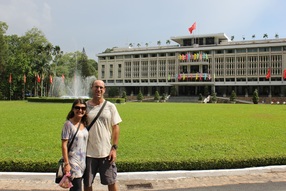 When we first arrived, we visited the Reunification Palace where the president of Southern Vietnam resided. This is where, on April 30, 1975, a North Vietnamese army tank shattered the front gates of the palace and ended the Vietnam war (or American War based on how you see it). It was interesting to see the different rooms in the palace and how the president lived. One room was decorated with animal skulls and even real dried hollowed out elephant feet. We even saw the secret passage to the bomb shelter! We ended the evening sampling the local street food and beers. Our second day in Sagon was tainted by a virus! Jeff fell very ill with a fever of 104, which alarmed us immediately. We contacted our travel insurance right away and they had a doctor at our door within minutes. It was Sunday night, so we were advised to wait until the morning to go to the hospital. After IV fluids and blood tests, we found out that he had contracted dengue hemorrhagic fever, which is different than just a dengue fever. The hemorrhagic fever usually occurs if you have been bitten by a dengue mosquito and bitten again by a mosquito carrying a different strain of the virus (there are 4 different strains of it). Dengue fever usually goes by without any complications but the dengue hemorrhagic fever has the chance to develop into a very serious condition including going into shock and possibly death. We spent the next week mostly in our hotel room. Jeff was in and out of sleep most of the time while I was out fetching coconuts and fresh fruit. The heat was really hard on him so he went out only at night to try to force down some dinner. We watched a lot of stupid movies during this time and reflected on our travels. Our next stop was going to be Jakarta and another month in Indonesia but full recovery of dengue fever is about 2 – 3 weeks, so we decided to roll with what circumstances were telling us and jet back to Bulgaria so Jeff can fully recover. Indonesia and other parts of SE Asia will have to wait – now we put Bulgaria and the rest of Europe in our sites! Barring any other life threatening tropical diseases :) – here we come! For the few pics we have from this leg, click here - http://flic.kr/s/aHsjzfMPPh.
The Mekong Delta is situated in Southern Vietnam and shares a western border with Cambodia. The land used to belong to Cambodia but by the 1600s, the Cambodians were too weak from fighting Thailand to prevent massive amounts of Vietnamese settlers from taking over the area and eventually annexing the land for Vietnam. 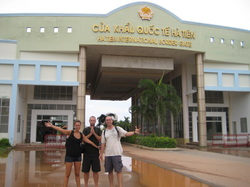 For all of us (we were still traveling with Chris and Lauren from the previous post) entering the delta was a bumpy affair. We arrived in Ha Tien, the Vietnamese border town, a bit shell shocked as the road conditions cause a constant hopping out of your seat and the standard way for Cambodian and Vietnamese drivers to let others know they are approaching is to just lay on the horn for minutes at a time. We had our first encounter with corruption at the border when we were asked to fill out an immunization form and pay $1 fee. This did not make any sense since we paid for our visa already, so we firmly refused to pay and just walked off. Obviously, this was a scam since there were no consequences. 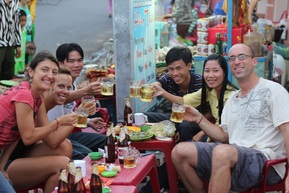 New friends at the street bar Ha Tien is a beautiful little town surrounded by water and fresh seafood! Like many towns in the delta, it is not touristy at all, which makes it all the more appealing to us. We happened to enter the country on 4/30, the day the Vietnam War (or the American War as it is called in Vietnam) ended. People were out celebrating everywhere, so we sat down at a small street bar (essentially small plastic chairs and aluminum tables) to check it out. We noticed that everyone was sharing dried fish and other sea creatures, so we were brave enough to try a dried sting ray. It wasn’t bad except the gut part – Chris almost had a gag reaction to that! Then, the youngsters next to us began toasting us and sharing their sea snails and roasted corn. We bought them a few beers and the party was on! It was great to feel included by strangers who didn’t speak a word of English, but who appreciated us trying the local cuisine and hanging out at the local spots. For pics from our stop here, click here - http://flic.kr/s/aHsjzaBBKd. 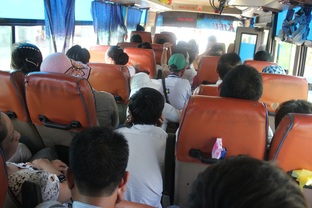 Bus packed like a sardine can! We were approached by a group of tour guides on motos who appeared to be such sweet people. They took us to see the wonderful cave pagoda the day we arrived and also offered to help us take the “local” bus to Can Tho the next morning. We had a pretty late night after we met Hayden, a Vietnamese student (just becoming a tour guide) from Can Tho. We went out on the town with Hayden and had a great time exploring traditional snacks with different Vietnamese beers. The next morning the guys, as promised, took us to the bus, but they had given us the wrong time to be there. As a result, the bus was already departing the bus station as they motored up to it and forced it to stop. We were surrounded by Vietnamese pulling our bags off of us and loading us on the bus. We realized they had intentionally done a rush job on us when the price of the tickets was more than double what we later found out everyone else had paid! But once you’re on the bus in the middle of nowhere you don’t have much choice. That was just the beginning of this horrific and comedic bus trip. Every few kilometers more and more people would load on the bus – we counted 28 seats on the bus and over 50 people! There were people in the middle of the aisles, 5 kids stuffed behind the back seats, and a hoard of people around the entrance. On top of that, we were dropped off at random locations two times and picked up by different buses. Amidst all of this crazyness, a sweet Vietnamese boy that spoke a few words of English helped us through this and made sure we got to Can Tho without being abandoned (one bus almost drove off with just Jeff and all of our valuables to the wrong destination!). The name of the post stems from a conversation where Hayden asked us what the term “Good Cop, Bad Cop” means. After explaining it to him, we realized it had some similarities to our experiences in Vietnam. For each lying, scheming, dishonest person we met in Vietnam, we also met some incredibly generous, caring, and thoughtful people. For us the challenge is to look past the bad cops and focus our attention on the good cops. As with so many things in life, our experience is dictated by where we focus our attention. While we can’t ignore the bad cops we have encountered, it would be an injustice to those truly good people we did meet. Many of the travelers we’ve talked to disliked Vietnam, so we weren’t sure what to expect, but so far, the good cop is winning and we are enjoying the country! Can Tho lies in the heart of the delta and as such is one of the most fertile towns in the world. We saw the freshest food so far sprawling along its market streets. Many of the fruits and vegetables sold here we have never even seen! Hayden is from Can Tho, so we met up with him again and he was a great host. He took us out to see the famous floating markets and some fruit orchards. He also took us to his hometown to meet his grandma and eat at a local restaurant. We were a little surprised by the chicken feet and neck they served, but we made the best of it! 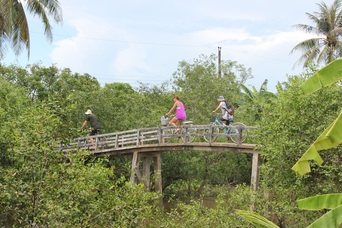 Biking on An Vinh on a beautiful day After Can Tho, we made a quick stop at a small town called Vinh Long where we took a ferry to An Binh island, lying in the middle of the Mekong river. The island is actually just pockets of land connected by small “monkey bridges” that are lots of fun to explore by bicycle. We spent the day biking around, crossing waterways and seeing all kinds of wonderful fruit plantations that the locals call home. For more pictures for this destination, click here - http://flic.kr/s/aHsjzerGeJ. Next, we continue on to Ho Chi Minh City and looking forward to a bigger city with a bit more of a nightlife!
Kampot, in the most Southeastern corner of Cambodia, was one of our favorite towns of our travels thus far. Set on the Kampot River, which is actually an estuary that flows right into the Gulf of Thailand, Kampot has managed to retain its small town charm. The people are incredibly friendly and every evening the locals would line the promenade along the river to watch the spectacular sunsets. 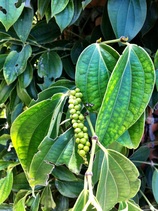 Of course, the part we enjoyed most was all the great food we found here, particularly because it was so locally produced! Kampot is a very unique place as this is where some of the world’s best pepper is grown. Pepper production has been recorded here as early as the 1200s and the region was a major producer until the Khmer Rouge destroyed the pepper plantations in the 70s. Things are now back in full swing and we took full advantage by eating freshly picked green peppercorns with popular seafood like shrimp and crab. Each dish would come with many sprigs of the pepper, which has a delightfully zesty, earthy spiciness when it is fresh. We have never tasted fresh pepper like that before as it usually has to be dried for preservation. We also visited the salt fields, where salt water pools rest peacefully under the sun letting the salt settle to the ground while the water evaporates. It is then collected and stored until it is ready to be bagged and sent to the market. As salt and pepper are staples on tables around the world these days, it got us thinking how eating local crab with local salt and pepper was really embodying the slogan “Go Local”. There is something beautiful about accepting the foods that a region produces at a given time and just eating those foods. We often have found here that when things are out of season people simply do not eat them, whereas in the Western world we spend enormous amounts of energy to import those things that don't grow nearby. That is not to say that it's always bad to import foods as sometimes it is necessary. But being around such simple delicious food that comes from within a few kilometers inspired us to think about eating more locally wherever we go. 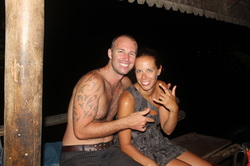 Chris and Lauren at Bodhivilla Though the food here was great, the best part about our visit to this town were the new and not so new anymore friends we met there. Our crew we met at the Gibbon Experience in Laos - Cat, Francis, and Claudia - rejoined us at Kampot. At our first dinner in town together, we met Chris and Lauren (see their travel blog here), another Kiwi and a Canadian, who happen to be staying at the same place as us! We ended up partying until 6am that morning at a Riverside bar and guesthouse called Bodhivilla. We danced the night away, swimming in the river in our undies, and seeing the town wake up and sun rise during our hour walk back to our guesthouse. 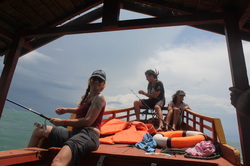 Dragon Dust, Francis, and Cat The day after the party, we persuaded Chris and Lauren to stick around for our sea fishing trip. Though it was cut slightly short due to a storm, it was fun to boat up the river and out into the sea and do some fishing. For us, it was “physical skill” aspect of Cambodia to learn about fishing in the sea. The “mental skill” was our study of Khmer architecture and history. In the end we caught some fish and grilled them up right on our boat on a little BBQ bucket that you see a lot around SE Asia. Our new friends were heading in the same direction as us, so we four continued to Vietnam together, while we had to say goodbye to our previous posse :(. We will miss them dearly and hope our paths cross again soon!!!! In the meantime, we head to the border town of Ha Tien to begin our exploration of the Mekong River Delta!
To see all the great pics of this leg, go here: http://flic.kr/s/aHsjzFxH3e |
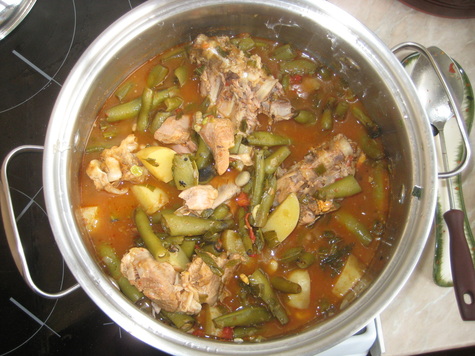
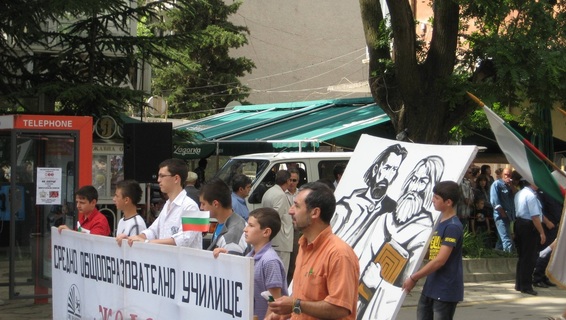
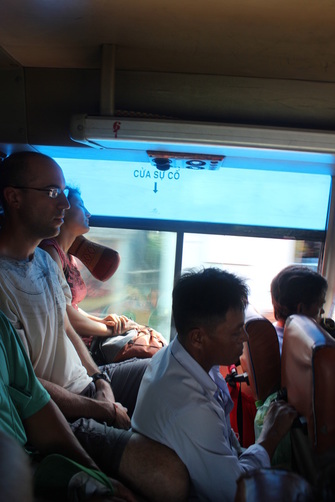
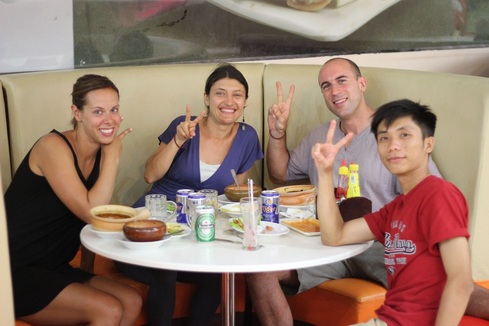
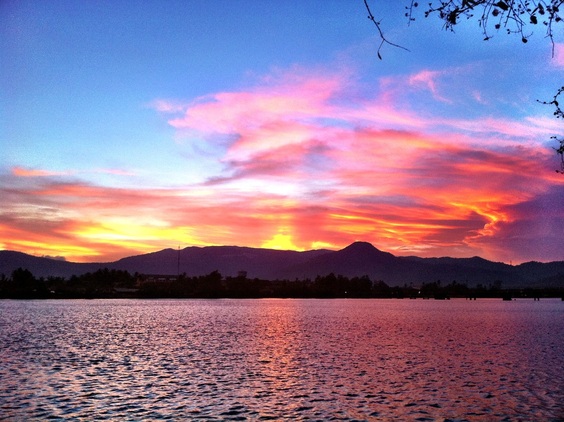
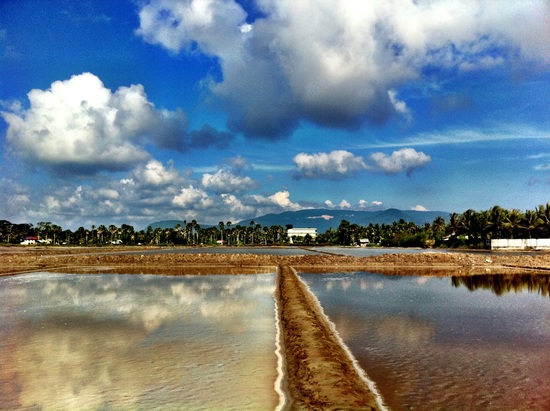
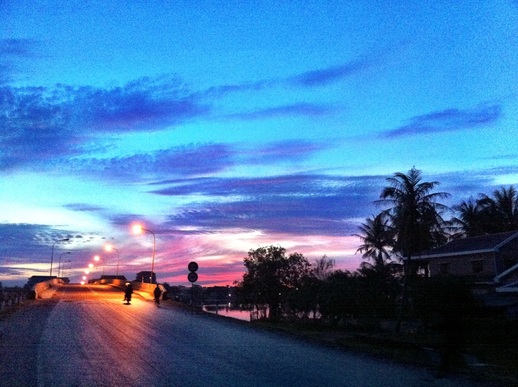
 RSS Feed
RSS Feed